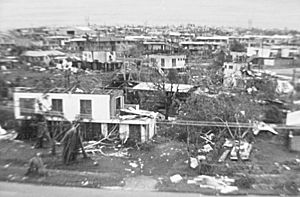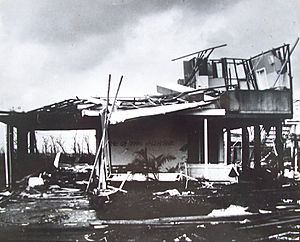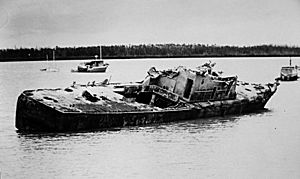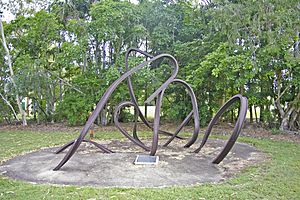Cyclone Tracy facts for kids
| Category 4 severe tropical cyclone (Aus scale) | |
|---|---|
| Category 3 tropical cyclone (SSHWS) | |
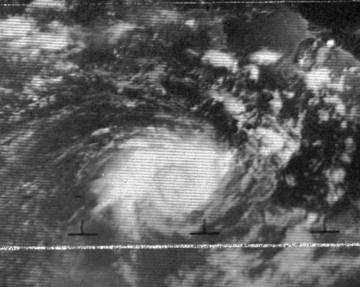
Cyclone Tracy on 25 December 1974
|
|
| Formed | December 21, 1974 |
| Dissipated | December 26, 1974 |
| Highest winds | 10-minute sustained: 175 km/h (110 mph) 1-minute sustained: 205 km/h (125 mph) Gusts: 240 km/h (150 mph) |
| Lowest pressure | 950 hPa (mbar); 28.05 inHg |
| Fatalities | 71 |
| Damage | $645.35 million (1974 USD) |
| Areas affected | Tiwi Islands, Northern Territory |
| Part of the 1974–75 Australian region cyclone season | |
Cyclone Tracy was a tropical cyclone that devastated the city of Darwin, Northern Territory, Australia, from December 24-26, 1974. Residents of Darwin were celebrating Christmas. They did not think much of the warnings, partly because another cyclone, (Selma), had already passed by the city. Also, only a few people were working the news outlets near Christmas.
Tracy killed 71 people and caused A$837 million in damage (in 1974 dollars), or approximately A$7.2 billion (in 2022 dollars), or US$5.2 billion (in 2022 dollars). It destroyed more than 70 percent of Darwin's buildings, including 80 percent of the houses. 30,000 people evacuated, and many never returned.
After the storm passed, the city was rebuilt using more strict standards "to cyclone code." The storm was the second-smallest tropical cyclone on record (in terms of gale-force wind diameter), behind only Tropical Storm Marco in 2008.
Contents
Meteorological history
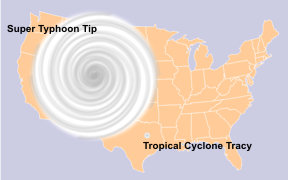
On December 20, 1974, meterologists saw a large cloud mass centered over the Arafura Sea about 230 miles (370 km) northeast of Darwin. The storm was officially pronounced a tropical cyclone at around 10:00 p.m. on December 21, when it was around 340 miles (550 km) northeast of Darwin). Cyclone Tracy was first observed on the Darwin radar on the morning of December 22.
A broadcast on ABC Radio that day said that Cyclone Tracy was not a threat to Darwin. However, early in the morning of December 24, Tracy rounded Cape Fourcroy on the western tip of Bathurst Island, and moved in a southeasterly direction, straight toward Darwin. The bureau's weather station at Cape Fourcroy measured a mean wind speed of 75 miles per hour (121 km/h) at 9:00 that morning.
Between 10:00 p.m. and midnight (local time), residents began to realize that the storm would pass directly over Darwin. The damage became severe. The anemometer (wind speed instrument) at Darwin Airport recorded a gust of 135 miles per hour (217 km/h) at 3:10 a.m. on December 25. The instrument failed at 3:10 a.m. The Bureau of Meteorology estimated that gusts reached 150 miles per hour (240 km/h). After making landfall, Tracy weakened quickly, and the storm was over on December 26.
Preparations
Darwin had been severely battered by cyclones before; in January 1897 and again in March 1937. However, in the twenty years leading up to Cyclone Tracy, the city of Darwin had grown quickly. The building standards at the time were not as strict as they are now. Most buildings were not able to withstand the direct hit of a cyclone.
On the days leading up to the cyclone, most people in Darwin believed that the cyclone would not cause any damage to the city. Cyclone Selma had been predicted to hit Darwin ten days earlier and had missed it. People had gotten used to hearing storm warnings and having no storm damage to the city, so they did not think much of the warnings that came before Tracy.
Impact
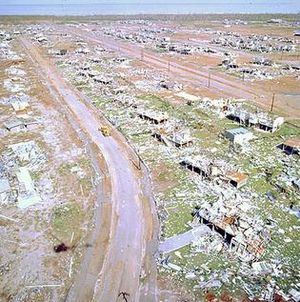
Courtesy – National Archives of Australia A6135, K29/1/16/75
Cyclone Tracy killed 71 people. It destroyed more than 70 percent of Darwin's buildings. The wharf and airport suffered damage as well. Two Royal Australian Navy (RAN) sailors died when HMAS Arrow, an Attack-class patrol boat, sank at Stokes Hill Wharf. The cyclone destroyed thirty-one aircraft and left another twenty-five badly damaged.
The Australian government created a committee to evaluate the damage and send help where it was needed. All of the Defense Force personnel throughout Australia, along with the entire Royal Australian Air Force's fleet of transport planes came to work to evacuate citizens from Darwin by road and by air. They also brought relief supplies to the area. Thirteen RAN ships were used to bring supplies to the area as part of Operation Navy Help Darwin. It was the largest humanitarian or disaster relief operation ever performed by the Navy.
Health and essential services crisis
On Christmas Day, the Darwin Hospital treated well over 500 patients. It was able to admit (let patients stay at the hospital) 112 patients. Local hospital employees worked until they got relief from a surgical team from Canberra.
All official communications out of Darwin did not work anymore. The antennas of most radio stations were destroyed during the storm. The only local radio station that wasn't completely disabled was ABC's 8DR. For the next two days, it was Darwin's only link to the outside world and was on the air for all but 34 hours in the coming weeks.
Approximately 30,000 people were homeless and were forced to seek shelter in several makeshift housing and emergency centers where there was no water or electricity. Because of the lack of proper hygienic conditions, many faced the threat of diseases. Volunteers came in from across the country to dig trench latrines, bring water supplies, and vaccinate for typhoid and cholera. The army searched for people and animals. They also cleaned out rotten food from refrigerators and freezers. After they had searched and cleaned a house, they painted "S&C" on an outside wall.
The city itself was sprayed with malathion to control mosquitoes and other similar pests. City services began to clear debris and restore their services where they could.
Aftermath
Reconstruction and effects on Darwin
In February 1975, Prime Minister Gough Whitlam announced the creation of the Darwin Reconstruction Commission. Its job was to rebuild the city within five years. Some people wanted to move the location of the city, but the government insisted that it be rebuilt in the same location. Ella Stack became the mayor of Darwin in May 1975 and was involved in the rebuilding. By 1978, much of the city had recovered and was able to house almost the same number of people as it had before the cyclone hit. However, by the 1980s, as many as sixty percent of Darwin's 1974 population had left, never to return. In the following years, Darwin was almost entirely rebuilt and now shows almost no resemblance to the pre-Tracy Darwin of December 1974.
In popular culture
Bill Cate wrote the song "Santa Never Made It into Darwin," and Bill and Boyd performed it in 1975 to raise money for the relief and rebuilding efforts. In May 1976, Australian band Ayers Rock released the single "Song for Darwin," also as a fundraiser for the relief and rebuilding efforts.
In 1986, the Nine Network and PBL created Cyclone Tracy, a period drama mini-series based on the events during the cyclone. Part of the film includes news video of the devastation and a documentary titled On A Wind and a Prayer.
Records and meteorological statistics
Tracy is the most compact (smallest in size) cyclone on record in the Australian basin and Southern Hemisphere. Its gale-force winds extended only 40 miles (64 km) from the center. It was also the smallest tropical cyclone worldwide until 2008, when Tropical Storm Marco of the 2008 Atlantic hurricane season broke the record, with gale-force winds extending only 12 miles (19 km) from the center.
Interesting facts about Cyclone Tracy
- Tracy was reported as a category four cyclone.
- People were not expecting Tracy to hit Darwin. There had been many false alarms before, and people thought the warnings for Tracy were another one.
- It changed direction and headed straight for Darwin.
- It was small but intense. Its gale-force winds extended only 40 miles (64 km) from the center.
- Darwin received 9.8 inches (250 mm) of rain in 12 hours.
- Most of Darwin's population was evacuated to Adelaide, Whyalla, Alice Springs, and Sydney.
- Cyclone Tracy remains one of Australia's greatest disasters.


